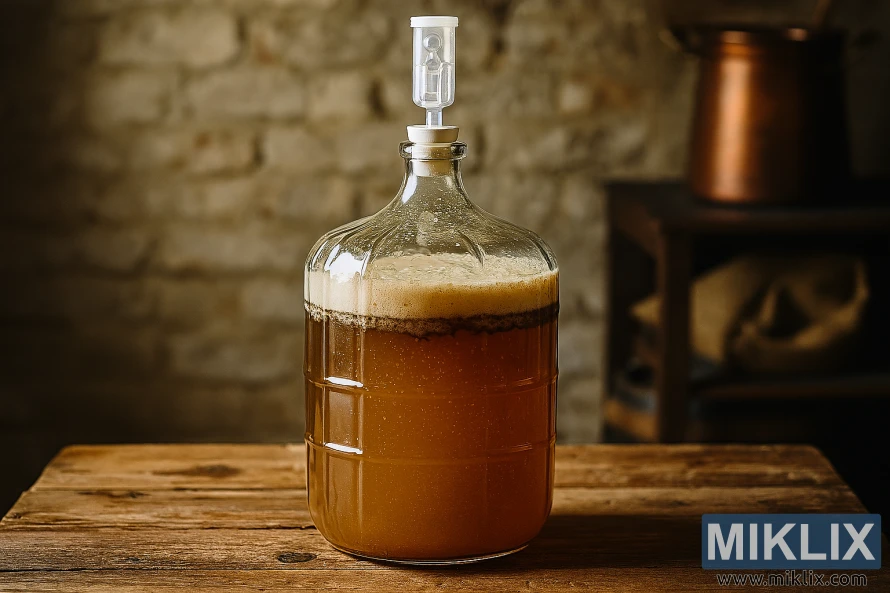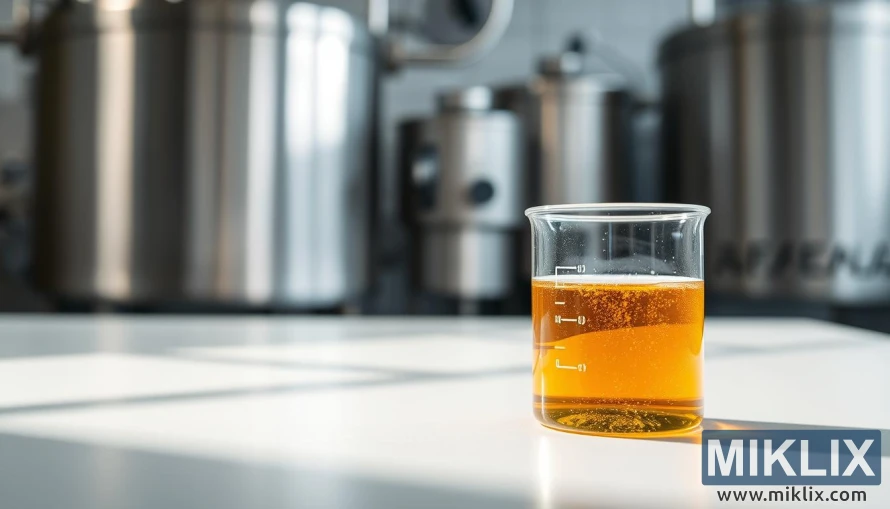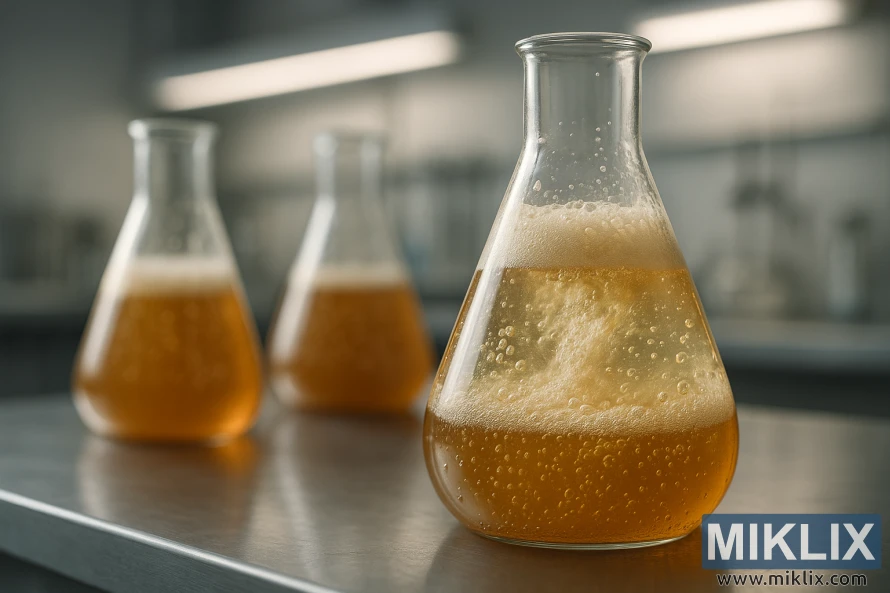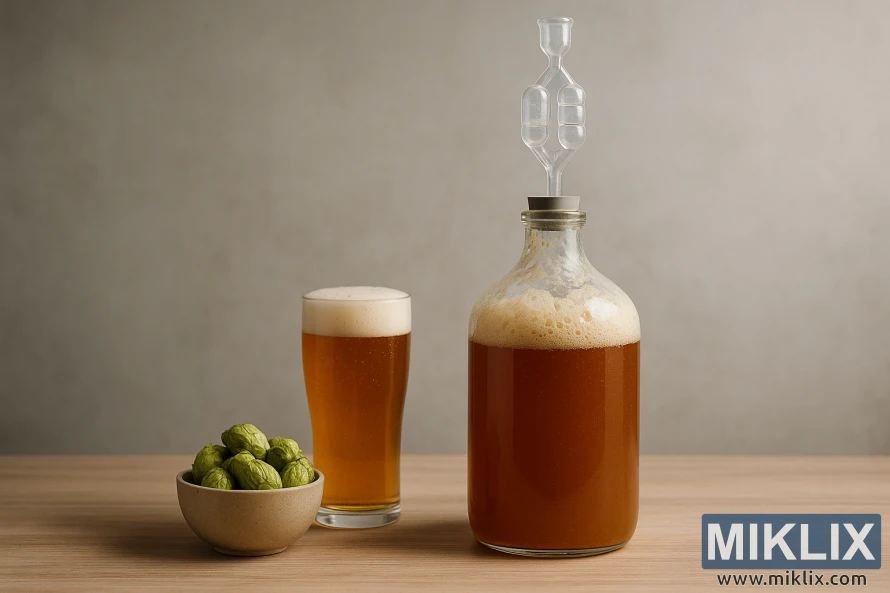Fermenting Beer with Fermentis SafAle F-2 Yeast
Published: August 12, 2025 at 6:24:12 AM UTC
Last updated: November 27, 2025 at 3:36:40 PM UTC
Fermentis SafAle F-2 Yeast is a dry Saccharomyces cerevisiae strain, designed for reliable secondary fermentations in bottle and cask. The yeast is ideal for bottle and cask conditioning, where gentle attenuation and steady CO2 uptake are critical. It ensures a clean flavor, making it perfect for brewers aiming for crisp, balanced carbonation. Fermentis F-2 is useful for refermentation without introducing off-flavors or excessive esters.

Key Takeaways
- Fermentis SafAle F-2 Yeast is a dry strain optimized for bottle and cask conditioning.
- The product is available in 25 g, 500 g, and 10 kg formats for homebrewers and commercial brewers.
- E2U™ formulation aids consistent rehydration and predictable pitching.
- Designed to deliver clean secondary fermentation with controlled carbonation.
- Recommended for styles that benefit from subtle refermentation and low ester impact.
What is Fermentis SafAle F-2 Yeast
SafAle F-2 is a dry ale yeast from Fermentis, a part of the Lesaffre group. It's a Saccharomyces cerevisiae strain, ideal for secondary conditioning in bottles and casks.
The product label reveals yeast (Saccharomyces cerevisiae) with emulsifier E491. Dry weight is between 94.0 to 96.5 percent, indicating high cell concentration and low moisture.
Cells are dried using Fermentis E2U™, preserving their peak viability. After rehydration, E2U rehydration yeast rapidly regains its fermentative activity. This makes it dependable for targeted refermentation tasks.
Fermentis produces SafAle F-2 under strict industrial microbiological controls. Brewers enjoy predictable performance, consistent attenuation, and the assurance of a global yeast producer.
- Strain role: targeted for bottle and cask refermentation.
- Composition: Saccharomyces cerevisiae for refermentation with E491 emulsifier.
- Processing: E2U rehydration yeast technology for rapid recovery.
- Source: produced by Fermentis/Lesaffre, meeting commercial purity standards.
Why choose SafAle F-2 for bottle and cask conditioning
SafAle F-2 is designed for refermentation in bottles and casks, ensuring the beer's original taste is preserved. It's a top choice for brewers seeking a yeast that doesn't alter the beer's flavor. Its neutral profile means it doesn't introduce esters or phenolics, keeping the beer's character intact.
This yeast supports the carbonation and gentle maturation aromas during secondary conditioning. As a cask conditioning yeast, it traps residual oxygen. This helps maintain the beer's aroma and flavor over time.
Its high alcohol tolerance makes SafAle F-2 ideal for stronger beers that need refermentation above 10% ABV. This feature allows brewers to experiment with recipes without worrying about stalled conditioning.
- Neutral aroma impact keeps malt and hop character intact
- Consistent carbonation for bottle-conditioned packaging
- Works reliably in real ale cask service
The yeast's sedimentation behavior is a practical advantage. It settles evenly at the bottom of bottles and casks, creating a clean yeast bed. When stirred, it produces a pleasant haze that many brewers find appealing for bottle presentation.
Choosing the right strain is critical for final quality. For brewers considering bottle and cask conditioning yeast options, SafAle F-2 stands out. It offers predictability, minimal flavor interference, and robust performance across a variety of strengths.
Key technical specifications and lab-proven metrics
Fermentis SafAle F-2 boasts a high viable cell count and compact dry weight. The typical packaging lists viable yeast > 1.0 × 10^10 cfu/g. Sometimes, technical data shows >19 × 10^9/g. Dry weight ranges from 94.0 to 96.5%.
Laboratory tests confirm microbiological purity above 99.9% for commercial lots. Contaminants like lactic acid bacteria, acetic acid bacteria, Pediococcus, and wild yeast are below 1 cfu per 10^7 yeast cells. Total bacterial counts are under 5 cfu per 10^7 yeast cells, adhering to safety standards.
Testing adheres to EBC Analytica 4.2.6 and ASBC Microbiological Control-5D standards. These methods ensure consistent performance in bottle and cask conditioning.
Recommended fermentation and conditioning temperatures are 15–25°C (59–77°F). Carbonation kinetics indicate refermentation can finish in 1–2 weeks near 20–25°C. At 15°C, carbonation may take more than two weeks.
- Viable cell count: documented minimums and routine quality checks.
- Microbiological purity: strict limits on bacteria and wild yeasts.
- Fermentation range: practical guidance for conditioning and carbonation time.
- Shelf life: clear dating and storage advice on each sachet.
Packaging and shelf life are specified as 36 months from production. Each sachet has a printed “best before” date and transport tolerances noted in the technical sheet. Proper storage maintains viable cell count and microbiological purity over the stated shelf life.
Dosage, rehydration and pitching protocols for optimal results
For bottle or cask conditioning, aim for a SafAle F-2 dosage that aligns with your refermentation objectives. The standard pitching rate ranges from 2 to 7 g/hl for typical conditioning. For more intense inoculation or quicker refermentation, some brewers opt for up to 35 g/hl. Adjust the dosage based on beer strength, temperature, and desired carbonation speed.
Adhere to precise rehydration instructions to preserve cell viability. Avoid adding dry yeast directly to sweetened beer. Instead, sprinkle yeast into at least ten times its weight of sterile, chlorine-free water at 25–29°C (77–84°F).
Allow the yeast to rest for 15–30 minutes before gently stirring to resuspend. These E2U rehydration steps are critical for restoring cell membranes and reducing stress during transfer into wort or primed beer.
When using priming sugar, ensure it is dissolved and evenly mixed before adding yeast. A 5–10 grams of sugar per liter of beer typically aims for a CO2 increase in the 2.5–5.0 g/L range, depending on initial carbonation and style.
Pitch the rehydrated yeast into sweetened beer at the conditioning temperature. Match the pitching rate to the beer volume and desired refermentation time. A lower pitching rate will slow carbonation, while a higher rate will shorten the time to reach the CO2 target.
Carbonation should occur within 1–2 weeks at 20–25°C. At 15°C, allow over two weeks for full CO2 development. Post-refermentation, cold storage and maturation for 2–3 weeks will enhance flavor roundness and clarity.
- SafAle F-2 dosage: choose 2–7 g/hl for routine conditioning; raise up to 35 g/hl for rapid results.
- Rehydration instructions: sprinkle into 10× sterile water at 25–29°C, rest 15–30 minutes, stir gently.
- Pitching rate: add rehydrated yeast to sweetened beer at conditioning temperature.
- E2U rehydration: follow this protocol to maximize viability and activity before transfer.
Keep records of temperature, sugar dose, and pitching rate for each batch. Small adjustments to SafAle F-2 dosage and timing lead to predictable carbonation and consistent bottle or cask conditioning outcomes.

Practical refermentation steps and priming sugar guidance
Begin by determining the amount of priming sugar needed based on your CO2 goals. Aim for 5–10 g sugar per liter to achieve 2.5–5.0 g/L CO2. For a 500 mL bottle, you'll need about 10–20 g of sugar, depending on the desired carbonation level.
To ensure consistent results, follow a structured bottle refermentation steps process. Start by preparing sterile water at 25–29°C. Then, rehydrate Fermentis SafAle F-2 yeast at a 10× ratio for 15–30 minutes. Stir gently to protect the yeast cells.
- Add 5–10 g/L priming sugar, using sucrose or dextrose, evenly to the beer.
- Adjust the beer's temperature to 20–25°C for faster carbonation. For slower conditioning, aim for 15–25°C.
- Pitch the rehydrated yeast into the sweetened beer. Then, package the beer into bottles or casks.
- Allow carbonation to develop. Expect 1–2 weeks at 20–25°C, or more than 2 weeks at 15°C.
- Once carbonated, chill the bottles or casks. Let the beer rest for 2–3 weeks to mature the flavors.
For cask priming, maintain strict cask hygiene and control venting. Proper venting prevents overpressure and ensures the beer reaches the desired CO2 levels. Monitor the headspace and adhere to sanitation standards similar to those for bottles.
Even sugar distribution is key for bottle refermentation. Use gentle mixing and avoid splashing to minimize oxygen pickup. Accurate priming sugar amounts and consistent temperatures lead to even carbonation and a predictable mouthfeel throughout the batch.
Handling, storage and shelf-life best practices
When storing SafAle F-2, first check the "best before" date on the sachet. It has a 36-month shelf life from production. For use within six months, keep it below 24°C. For longer storage, aim for temperatures under 15°C at the final destination.
Technical guidance suggests storing packets in cool, dry conditions under 10°C (50°F) when possible. This protects viability and extends yeast shelf life. It ensures consistent fermentation performance for both homebrewers and breweries.
Transport conditions can vary by route and season. The yeast tolerates room temperature transport for up to three months without performance loss in typical supply chains. Brief warm spells should be limited to seven days to avoid cell stress.
Opened sachet handling is critical for safety and effectiveness. If a sachet is opened, reseal it or transfer contents to an airtight container and store at 4°C (39°F). Use the remaining yeast within seven days. Do not use soft, swollen, or damaged sachets.
Packaging is available in 25 g, 500 g, and 10 kg formats for single batches and commercial production. Choose the right format to reduce repeated opening and simplify cold storage. This helps preserve yeast shelf life and purity.
- Use sterile water for rehydration and follow the temperature guidelines on the technical sheet.
- Avoid rehydrating yeast directly in beer or wort; this prevents osmotic shock and contamination.
- Maintain good hygiene and clean handling areas to protect viability and microbiological quality.
Following these handling routines improves consistency and lowers the risk of stalled refermentation. Good control of transport conditions and opened sachet handling ensures peak viability for brewing schedules.
Flocculation, haze behavior and bottle/cask conditioning outcomes
SafAle F-2 flocculation exhibits a consistent pattern. At fermentation's end, the yeast settles uniformly, forming a dense bed. This facilitates cold-conditioning and clarification, aiming for a refined pour.
When bottles or casks are moved, a controlled haze forms. This haze is ideal for cask service and styles that benefit from a soft, expressive cloud. Brewers seeking clarity can decant above the lees.
The yeast's behavior results in a clear ring at the bottom of containers. This ring simplifies serving and minimizes yeast carryover. For bottle-conditioned ales, it ensures predictable sediment, aiding in shelf stability.
Conditioning outcomes include natural carbonation and subtle flavor rounding. Oxygen trapped during conditioning is minimized, preserving freshness. The maturation aromas that develop add complexity without obscuring hop or malt flavors.
- Even settling reduces the need for extended cold breaks.
- Resuspendable haze supports traditional cask presentations.
- Clear decanting possible thanks to consistent sediment behavior.
In practice, SafAle F-2 flocculation strikes a balance between clarity and haze. Its predictable conditioning outcomes make it a practical choice for both bottle and cask-conditioned beers.
Fermentation kinetics and sugar assimilation profile
SafAle F-2 exhibits a distinct sugar assimilation pattern. It efficiently breaks down glucose, fructose, sucrose, and maltose. Yet, it consumes very little maltotriose. This limited maltotriose uptake helps maintain the beer's body.
The fermentation kinetics for refermentation are consistent. Active carbonation occurs between 15–25°C, with the fastest activity at 20–25°C. In this range, visible carbonation forms in one to two weeks. Activity slows near 15°C, so extra time is needed at lower temperatures.
The residual sugar profile shows limited maltotriose uptake. Expect measurable residual maltotriose in the final beer. This reduces the risk of over-attenuation when using priming sugar correctly. The residual sugar also enhances mouthfeel and balance in cask or bottle conditioning.
- Perform small-scale trials to confirm fermentation kinetics in your wort and packaging conditions.
- Measure attenuation and residual sugar profile after refermentation to adjust priming levels safely.
- Compare alcohol production and flocculation in lab trials to match commercial targets.
Brewers aiming for controlled carbonation and consistent body will find SafAle F-2's traits beneficial. Trial runs are essential to determine the right priming sugar and conditioning time. Local variables in temperature and wort composition must be considered.
Sanitation, purity and microbiological safety considerations
When handling Fermentis SafAle F-2, it's essential to uphold strict yeast purity standards. Quality control records confirm purity levels exceeding 99.9%. The goal is to keep contaminants like lactic acid bacteria, acetic acid bacteria, Pediococcus, and wild non-Saccharomyces yeasts under 1 cfu per 10^7 yeast cells.
During rehydration and transfer, adhere to microbial limits SafAle F-2. Total bacterial counts should not exceed 5 cfu per 10^7 yeast cells. Use sterile water for rehydration to prevent contamination that could alter flavor or cause off-odors.
Implementing simple sanitation measures in the brewery is critical for refermentation hygiene. Sanitize packaging, racking hoses, bottling lines, and caps. Regularly clean fermenters and serving vessels between batches to minimize cross-contamination risks.
- Sanitize all surfaces in contact with yeast and wort.
- Use single-use sterile filters or properly validated cleaning cycles for reusable items.
- Keep rehydration and priming areas physically separate from open fermentation rooms.
Adhere to Fermentis quality assurance from Lesaffre group production to ensure pathogen compliance. This approach controls pathogenic micro-organisms according to regulations, reducing risks in the finished beer.
Scaling up to commercial volumes requires running trial batches and monitoring microbial limits SafAle F-2 closely. Validate rehydration and pitching protocols, and maintain cold chain storage to preserve viability and lower contamination risk.
Mix priming sugar uniformly to prevent localized overcarbonation and infection hotspots. Consistent mixing supports hygiene for refermentation and helps protect head retention and carbonation targets.
Document results and keep records of microbial testing. Routine checks reinforce yeast purity standards and provide evidence that sanitation practices meet production goals.

Recipe and style recommendations for using SafAle F-2
SafAle F-2 excels in creating a neutral yeast character. It's ideal for English and continental ales, traditional cask ales, and stronger bottle-conditioned ales above 10% ABV. These styles benefit from a retained body and a soft mouthfeel.
When crafting recipes, aim to preserve the base malt aroma and hop profile. Low maltotriose assimilation means you can retain some dextrins and body. This suits amber bitters, porters with residual sweetness, and strong ales needing refermentation stability.
Adopt practical refermentation recipes that align with your carbonation goals. For cask ales, aim for lower carbonation, around 2.5 g/L CO2. For sparkling bottle-conditioned styles, target 4.5–5.0 g/L CO2. Use 5–10 g/L priming sugar, depending on bottle size and desired effervescence.
- Traditional cask-conditioned bitters: moderate OG, gentle hopping, low carbonation target for cellar service.
- English-style bitters for bottles: preserve malt backbone, target 2.5–3.0 g/L CO2, use 6–8 g/L priming sugar.
- Strong bottle-conditioned ales (>10% ABV): prioritize refermentation recipes that include bolstered yeast health and measured priming sugar to avoid over-carbonation.
Follow conditioning yeast recommendations by pitching an active, healthy starter or using an appropriate dose of dry yeast at bottling. This reduces lag and ensures clean refermentation without altering hop character.
Avoid SafAle F-2 for a very dry, fully attenuated finish. For such beers, choose a more attenuative strain. For most cask and bottle-conditioned ales, these recommendations help achieve stable carbonation and a balanced final profile.
Troubleshooting common issues during refermentation
Refermentation problems often stem from a few common causes. Slow carbonation with SafAle F-2 can be due to low conditioning temperatures, insufficient viable yeast, or improper rehydration. At 15°C, carbonation may take over two weeks.
Before pitching, verify the sachet date and its storage history. Old or heat-stressed Fermentis SafAle F-2 will not perform well. If viability seems low, consider a small starter or a controlled re-pitch at the recommended dose.
- Slow carbonation SafAle F-2: raise conditioning temperature within the yeast’s range to speed activity.
- Refermentation problems from underdosing: follow the packet dosage or perform a viability count for accuracy.
- Refermentation troubleshooting for inactive yeast: rehydrate exactly per Fermentis instructions; do not rely on in-beer rehydration.
To prevent overcarbonation, start with accurate priming sugar dosing. Use 5–10 g/L as a guideline based on style and residual fermentables. Measure sugar by weight and mix uniformly to avoid uneven CO2 levels in bottles.
- Weigh priming sugar precisely and dissolve in boiling water for even distribution.
- Ensure consistent pitching rates to match expected drop‑out and yeast activity.
- Cold crash or cold condition for 2–3 weeks to help yeast settle and reduce sediment issues.
If off-flavors or altered aroma appear, first check for microbial contamination. Microbes are less likely when sanitation and purity standards are observed. Stressed yeast from poor rehydration or excess oxygen can produce esters or sulfur notes instead.
Poor flocculation and persistent haze can be corrected by checking pitching rate and conditioning regime. Proper maturation, with a period of cool conditioning, encourages yeast to flocculate and drop out of suspension.
For remediation, run small trial batches when changing a process. Increase conditioning temperature slightly to accelerate refermentation or allow extra time at recommended temps. Recheck sachet storage and date before scaling the fix.
Follow these refermentation troubleshooting steps to reduce risks, ensure consistent conditioning, and keep overcarbonation prevention front of mind during bottle and cask work.
Fermentis SafAle F-2 Yeast
This Fermentis product overview focuses on SafAle F-2, a dry ale yeast designed for bottle and cask refermentation. It offers a neutral aroma, preserving the base beer's character while ensuring reliable carbonation and shelf stability. Brewers aiming for consistent results will find the SafAle F-2 summary invaluable for conditioning and priming.
Technical details highlight the yeast's robustness: it boasts over 1.0 × 10^10 cfu/g viable cells and purity above 99.9%. Conditioning is recommended between 15–25°C. Rehydration in sterile water at 25–29°C for 15–30 minutes is optimal. For priming, use 5–10 g/L sugar to achieve 2.5–5.0 g/L CO2.
Practical application showcases limited maltotriose assimilation and alcohol tolerance up to 10% v/v. These characteristics help maintain clarity and prevent unexpected flavor changes during secondary carbonation. Flocculation is consistent, improving shelf appearance and pour quality for bottles and casks.
Manufacturer support is available through technical data sheets and trial recommendations. Fermentis relies on Lesaffre brewing yeast expertise for quality and production standards. Brewers are advised to conduct small-scale trials before scaling up to commercial batches.
- Best use: bottle and cask refermentation for neutral profile.
- Pitching: follow rehydration window and target conditioning temp.
- Carbonation: priming sugar 5–10 g/L for 2.5–5.0 g/L CO2.
In summary, this concise overview and SafAle F-2 summary position the yeast as a dependable choice for brewers seeking consistency. The Lesaffre brewing yeast lineage enhances manufacturing confidence, supporting both craft and larger-scale operations.
Conclusion
Fermentis SafAle F-2 is a dry yeast designed for bottle and cask conditioning. It offers a neutral aroma, consistent viability, and high microbiological purity. Brewers looking for predictable settling and minimal flavor impact will find it ideal for both homebrewing and professional use.
To achieve the best results, follow Fermentis's rehydration and pitching guidelines. Never rehydrate the yeast directly in beer. Use 5–10 g/L priming sugar to target 2.5–5.0 g/L CO2 levels. Condition at 15–25°C, with 20–25°C speeding up carbonation. Allow 2–3 weeks of cold maturation for rounding and clarity.
Based on this review, it's wise to run small-scale trials with your recipe. This will help confirm carbonation timing and sensory results before scaling up. Store SafAle F-2 as directed by the manufacturer to ensure viability. This will guarantee reliable refermentation performance and consistent results across batches.

Further Reading
If you enjoyed this post, you may also like these suggestions:
- Fermenting Beer with CellarScience Cali Yeast
- Fermenting Beer with Lallemand LalBrew Windsor Yeast
- Fermenting Beer with White Labs WLP095 Burlington Ale Yeast
